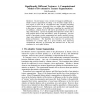Free Online Productivity Tools
i2Speak
i2Symbol
i2OCR
iTex2Img
iWeb2Print
iWeb2Shot
i2Type
iPdf2Split
iPdf2Merge
i2Bopomofo
i2Arabic
i2Style
i2Image
i2PDF
iLatex2Rtf
Sci2ools
91
Voted
ECCV
2000
Springer
2000
Springer
Significantly Different Textures: A Computational Model of Pre-attentive Texture Segmentation
Abstract. Recent human vision research [1] suggests modelling preattentive texture segmentation by taking a set of feature samples from a local region on each side of a hypothesized edge, and then performing standard statistical tests to determine if the two samples differ significantly in their mean or variance. If the difference is significant at a specified level of confidence, a human observer will tend to pre-attentively see a texture edge at that location. I present an algorithm based upon these results, with a well specified decision stage and intuitive, easily fit parameters. Previous models of pre-attentive texture segmentation have poorly specified decision stages, more unknown free parameters, and in some cases incorrectly model human performance. The algorithm uses heuristics for guessing the orientation of a texture edge at a given location, thus improving computational efficiency by performing the statistical tests at only one orientation for each spatial location. 1 Pre-...
Computer Vision | ECCV 2000 | Human Observer | Pre-attentive Texture Segmentation | Preattentive Texture Segmentation | Segmentation Pre-attentive Texture | Texture Edge |
Related Content
| Added | 16 Oct 2009 |
| Updated | 16 Oct 2009 |
| Type | Conference |
| Year | 2000 |
| Where | ECCV |
| Authors | Ruth Rosenholz |
Comments (0)

